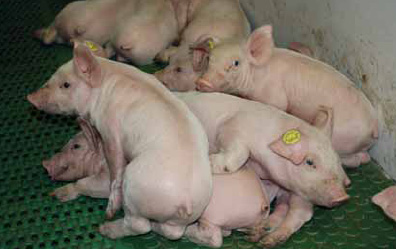Resurgence of milk replacers

Milk replacers can be used in various ways – one option is to use them as a temporal fix when a sow does not produce sufficient amounts of milk; another is to apply them in a structural approach as sows produce increasingly larger litters anyway. This overview aims to give a comprehensive summary of various applications of milk replacers.
By Dr Ioannis Mavromichalis, international consulting nutritionist, Ariston Nutrition, Madrid, Spain
Milk replacer products have been around for quite some time now. As a quick solution to a sow’s milk deficiency, for any reason, they have been a quick tool (it only takes a few minutes to dilute the powder in lukewarm water) to address an occasional problem at almost every farm. But, today, we see liquid milk replacers at almost every farm, especially in Europe, where hyperprolific sows are pushing the limit of numbers reared per year to above 30 piglets.
Although these days producers have larger litters due to improved genetics (and better nutrition, health, management, facilities, etc), the industry has not been so fortunate when it comes to sow’s milk yield. Now, when litter size increases, it is well known that total milk yield increases, albeit not in a proportional manner. As such, with each additional piglet per litter, milk intake per piglet actually decreases. Hence, the resurgence of milk replacers to address this new problem in pig husbandry.
Always a partial replacement
It should be stressed here that it would be perfectly acceptable from a commercial point of view, we cannot replace sow’s milk completely. That is, with all advances in science, we still depend on the sow to provide the majority of nutrients for newborn pigs. Although complete artificial rearing is possible, it is still widely accepted that under current commercial conditions, it is definitely more efficient and safer to allow a sow to suckle her litter, instead of weaning her very early and rearing the piglets with milk replacers.
The focus of recent attention in the technology of milk replacers is entirely as a partial replacement, or rather as a ‘boost’ to natural milk. If this is done properly – to supply underprivileged litters with the right type of milk replacer, at the right time and quantity – many otherwise lost piglets can be saved and satisfactory growth levels maintained throughout life.
A useful tool
The most common application of milk replacers is for supplementing piglets on the sow. The most common incidence today is the case of hyper-prolific sows that require a ‘helping hand’ in rearing their litters. In addition, quite often, some sows, hyper-prolific or not, may experience depressed milk production due to health problems (e.g., metritis-mastitis-agalactia), reduced appetite, or stressful environmental conditions (e.g., summer heat) while others, with adequate milk yield, may not have enough functional teats to support their current litter. With no doubt, the best solution to milk shortage is piglet fostering.
However, this is not always feasible as there may not be enough foster sows or the piglets may be too old to be fostered when the problem arises. In these cases, competition among piglets, for a limited supply of milk, becomes extremely strong and unless an external source of nutrients is provided, growth rate and survival are detrimentally affected. Under such circumstances, a liquid milk replacer is the ideal solution, especially for very young piglets.
Rearing orphan piglets away from a sow is another area where milk replacers are used with great benefit as a last resort when foster sows are not available. Piglets, always after receiving some colostrum are penned in small groups (up to ten piglets) in commercial or hand-made brooders, where hygiene and environmental conditions are totally under control and a higher degree of care and management is possible. A warm solution of milk replacer is offered through a nipple or a cup up to the age of 17-21 days. However, from the second week, milk pellets or a high quality creep feed are liberally offered while water is always available from the very beginning. For weaning a piglet in three weeks, approximately 2.0-4.0 kg of milk replacer powder and 1.0-2.0 kg of creep feed are needed. A typical feeding programme is illustrated in Table 1.
Post-weaning applications
The term ‘wet’ weaning describes a new concept under which, whole litters or groups of small piglets are fed with a liquid milk replacer, in addition to dry feed (usually a creep diet), for a short period of time (two to five days) immediately after weaning. Research has shown that ‘wet’ weaning helps piglets overcome the usual feeding disorders associated with early weaning. With wet weaning, the digestive system adapts more easily to dry feed, diarrhoea is prevented, and piglets gain weight faster.
However, the success of this system depends largely on proper management of the liquid feeding part, and it has increased requirements in capital (extra facilities) and labour. In general terms, in five days, piglets consume about 1.0 kg of milk replacer powder and gain about 1.0-2.0 kg more than piglets that consume only dry feed.
Selecting the right milk replacers
The nutrient composition of sow’s milk is given in Table 2. It is obvious that sows produce a rather thick milk, especially rich in fat. As a result, an ideal milk replacer powder, with a high dry matter content (94-96 % due to special ingredients) would be used at a mixing rate of no less than 20%.This mixing rate would give a solution equal in composition to natural milk. However, such a dense powder would be too difficult to market, due to high cost, and even more difficult to manufacture, due to its high fat specification.
Therefore, commercial milk replacer powder products are manufactured to be mixed (with water) at a rate of 10-15% to provide a rather thinner solution. Usually, 1 kg of a liquid milk replacer equals about 0.5-0.75 kg of sow milk. Given the enormous potential for milk intake by young piglets, this dilution does not cause any setback in their growth and development. An alternative solution is to offer a product that is diluted at 20%, but with less fat. When reconstituted, the liquid milk replacer resembles sow’s milk but with less energy. In general, the closer to the ‘ideal’ milk replacer a commercial product is, the better the animal performance will be, but price will also be accordingly higher.Even more important than nutrient specifications is the ingredient composition of a commercial milk replacer powder. Piglets have a specific digestive capacity suited best to digesting milk components.
Therefore, milk based ingredients like skim milk, whey, lactose, buttermilk, and their derivatives should make up the majority of any high quality milk replacer formulation.Moreover, the formula should also contain easily digested lipids (coconut fat, vegetable oils), sucrose, perhaps taste and flavour enchancers, vitamins, trace minerals, organic acids, and any required medications. It should be noted that purified vegetable proteins (e.g. soy protein concentrate, potato or pea protein, wheat gluten, etc) may be incorporated but only in small amounts to lower price but in this case, quality deteriorates considerably. Lecithin is usually used as an emulsifier.Today, most high quality milk replacers are fortified with a source of immunoglobulins because sow’s milk is a rich source of these important ‘functional nutrients’ that keep piglets healthy. There are three sources of immunoglobulins: dried bovine colostrum (which is very expensive), dried animal plasma (which is relatively expensive, and even not allowed in some countries), and egg-derived immunoglobulins (which are designed to act specifically against piglet diseases). Today, the technology of egg-derived immunoglobulins has evolved so much that it is a commercial product and it is used almost exclusively (first for price, but also for higher specificity, and absence of problems) as the source of choice of immunoglobulins in milk replacer powders. Milk replacers without immunoglobulin fortification can nourish the piglets but not protect them, thus offering only half of the features piglets enjoy through natural milk.
Finally, the physical characteristics of a high quality milk replacer include freshness, stability in solution up to two days, minimal fat separation and protein flocculation, high solubility, a creamy white colour with a typical milk smell and of course it should be non hygroscopic, to facilitate usage and storage. Manufacturers always specify the exact temperature, time, pH conditions that are best for their own products, and these should be followed meticulously.
Feeding management
When selecting feeders for liquid milk replacers, it must be kept in mind that piglets prefer to eat communally. Feeders with six to eight places are better suited for piglets reared away from a sow while those with only one to two holes, or individual cups and nipples, are best for supplementing piglets on the sow. Plastic and galvanised metal feeders are usually preferred. In any way, this piece of equipment should be portable, durable and easily cleaned and filled, every day. Today, where milk replacers are used in every farrowing crate, a mechanised system of mixing and delivery is installed, usually by the supplier of the milk replacer powder (or vice versa). Most such systems do not work with any milk replacer so it is best to obtain a package (system and powder) that are known to work together.
Sanitation is another key factor in successfully implementing liquid nutrition, including of course that with milk replacers. Apart from overall high hygiene, it should be stressed that feeders must be rinsed daily and thoroughly cleaned and disinfected within litters.
Mixing milk powder with cold, tepid or warm water should be done thoroughly and manufacturer’s dosages and guidelines precisely followed. Some milk replacers must never be mixed with warm water, while none should be mixed with hot water as nutrient degradation (e.g. vitamins) may occur. It is strongly recommended that a fresh solution be prepared every day, even though some mixes may stay in good suspension for two to three days.In case of diarrhoea, daily allowances of milk replacer should be lowered and an antibiotic treatment followed according to veterinarian prescription. Overfeeding as well as poor hygiene conditions are the main causes of diarrhoea. Veterinary inspection and supervision is always beneficial, especially when starting a new feeding method.
Consumption of dry feed (creep diet, starter) should be started as soon as possible. Piglets with high dry feed intake can be weaned earlier, with fewer post-weaning problems, and certainly consume less milk replacer. The creep diet should be palatable, highly digestible and offered at a pattern of ‘little and often’. Gradually lowering liquid milk allotment, towards weaning, makes piglets look for another source of nutrients to satisfy their needs. Dry feed intake increases considerably when fresh water is always available, ad libitum.











